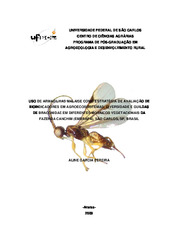Uso de armadilhas Malaise como estratégia de avaliação de bioindicadores em agroecossistemas : diversidade e guildas de Braconidae em diferentes mosaicos vegetacionais da Fazenda Canchim (Embrapa), São Carlos, SP, Brasil
Resumen
This work aimed to study the composition and distribution of the fauna of Braconidae (Hymenoptera) in three ecosystems of Fazenda Canchim (Embrapa, Sao Carlos, Brazil), analyse the bioindicator potential of that group and its possible use by farmers in order to contribute for the use of a more sustainable agroecosystems. The specimens were captured by three Malaise traps installed respectively in a agrosilvipastoril system, atlantic forest and reforestation area (ecological corridor) from January to July of 2008. A total of 566 Braconidae specimens were collected distributed in 21 subfamilies and 57 genera. In the agrosilvipastoril area Earinus and Digonogastra were the most abundant; Dolichozele the was the more abundant in the area of reforestation and Apanteles in the atlantic forest .The agrosilvipastoril system showed the greatest richness of genera and in the atlantic forest was obtained a greater number of genera exclusive. The reforestation and agrosilvipastoril system showed high similarity, although this last had great human influence, resulting from the deployment of pasture. The reforestation is characterized by having characteristic vegetation considered as an ecological corridor, next to a place before occupied by degraded pasture. The atlantic forest is different from the others with good conditions to recovery of the original species. The improving conditions for regeneration, possibly harbors a rich fauna of insect hosts. The results indicate that in the three environments it was not reached the stage of asymptotic curves of accumulation, indicating the need of a longer period of sampling for a more precise knowledge of local fauna of Braconidae. In all environments there was a higher incidence of koinobiont endoparasitoids, which are specialists and therefore considered good bioindicators of the environmental quality.
